| 图片: | |
|---|---|
| 名称: | |
| 描述: | |
- Share a breast proliferative lesion cytology paper with you
| 姓 名: | ××× | 性别: | 年龄: | ||
| 标本名称: | |||||
| 简要病史: | |||||
| 肉眼检查: | |||||
| Cancer (Cancer cytopathology) April 25, 2009;117(2):137-47 Breast fine-needle aspiration samples reported as  proliferative breast lesion proliferative breast lesion : Clinical utility of the subcategory : Clinical utility of the subcategory  proliferative breast lesion with atypia proliferative breast lesion with atypia  |
Chengquan Zhao, MD 1 2 * §, Anwar Raza, MD 1 3, Sue E. Martin, MD, PhD 1, Jiangqiu Pan, MD 1, Timothy S. Greaves, MD 1, Camilla J. Cobb, MD 1 3 §, Anwar Raza, MD 1 3, Sue E. Martin, MD, PhD 1, Jiangqiu Pan, MD 1, Timothy S. Greaves, MD 1, Camilla J. Cobb, MD 1 3 |
| 1Department of Pathology, Los Angeles County + University of Southern California Medical Center, Los Angeles, California 2Department of Pathology, Magee-Womens Hospital, University of Pittsburgh Medical Center, Pittsburgh, Pennsylvania 3Department of Pathology, Loma Linda University Medical Center, Loma Linda, California |
| email: Chengquan Zhao (zhaoc@upmc.edu) |
*Correspondence to Chengquan Zhao, Department of Pathology, Magee-Womens Hospital, University of Pittsburgh Medical Center, Pittsburgh, PA 15213
 Presented at the 96th annual United State and Canadian Academy of Pathology Meeting in San Diego, California, March, 2007.
Presented at the 96th annual United State and Canadian Academy of Pathology Meeting in San Diego, California, March, 2007. Fax: (412) 641-1675
Fax: (412) 641-1675§The authors thank Dr. R Marshall Austin (Magee-Womens Hospital, University of Pittsburgh) for his help in reviewing this article.
setDOI("ADOI=10.1002/cncy.20003")
| Keywords |
| atypical proliferative breast lesion • fine-needle aspiration • breast cytology |
| Abstract |
BACKGROUND: |
The fine-needle aspiration (FNA) diagnosis of proliferative breast lesion is an indeterminate category. The aim of this correlative study was to determine whether a subcategory of  proliferative breast lesion with atypia proliferative breast lesion with atypia was achievable and whether this subcategory has management utility. was achievable and whether this subcategory has management utility. |
METHODS: |
| Breast FNA cases from 2000 through 2005 diagnosed as proliferative breast lesion and proliferative breast lesion with atypia were retrieved. Both cytologic and surgical slides of these cases were reviewed blindly. A cytologic diagnosis of proliferative breast lesion (without atypia) or proliferative breast lesion with atypia was used if the findings of the proliferative breast lesion did not fit a more specific category. |
RESULTS: |
| Of the 3934 breast FNAs performed on palpable breast masses from January 2000 to December 2005 at the LAC + USC Medical Center, 317 (8.1%) were diagnosed cytologically as proliferative breast lesion with atypia, without atypia or without mention of atypia. There was subsequent histopathology on 201 of these cases. After the cytologic smears were reviewed, 29 cases were excluded from this study. Of the 172 remaining cases, 21 (12.2%) were found to be malignant and the remaining 151 (87.8%) were found to be benign on histology. Of the malignant cases, 90% had an FNA diagnosis of proliferative breast lesion with atypia; of the benign cases, 78% were interpreted as proliferative breast lesion without atypia. |
CONCLUSIONS: |
| Proliferative breast lesion with atypia was clinically significant because it was associated with a significantly increased likelihood of malignancy compared with proliferative breast lesion without atypia. Most of the malignancies had hypocellularity or low nuclear grade on the FNA smears. Fibroadenoma accounted for most of the benign lesions in both proliferative breast lesion and proliferative breast lesion with atypia. Cancer (Cancer Cytopathol) 2009. © 2009 American Cancer Society. |
Received: 28 August 2008; Revised: 13 November 2008; Accepted: 10 December 2008
标签:
×参考诊断
-
本帖最后由 于 2009-04-14 06:22:00 编辑
Figure 2. Three cases of atypical proliferative breast lesions on fine-needle aspiration (FNA) cytology and diagnosed as fibroadenoma on histology specimens and 1 case of fibroadenoma on FNA cytology and histology. (A) A large, loosely cohesive cluster of ductal epithelial cells with nuclear atypia, prominent nucleoli, and rare myoepithelial cells; (B) cluster of ductal epithelial cells with nuclear atypia and rare myoepithelial cells; (C) cellular smear showing many single epithelial cells; (D) FNA cytology of fibroadenoma showing many single myoepithelial cells (A: Papanicolaou stain, original magnification ×400; B-D: Diff-Quick stain, original magnification ×400).
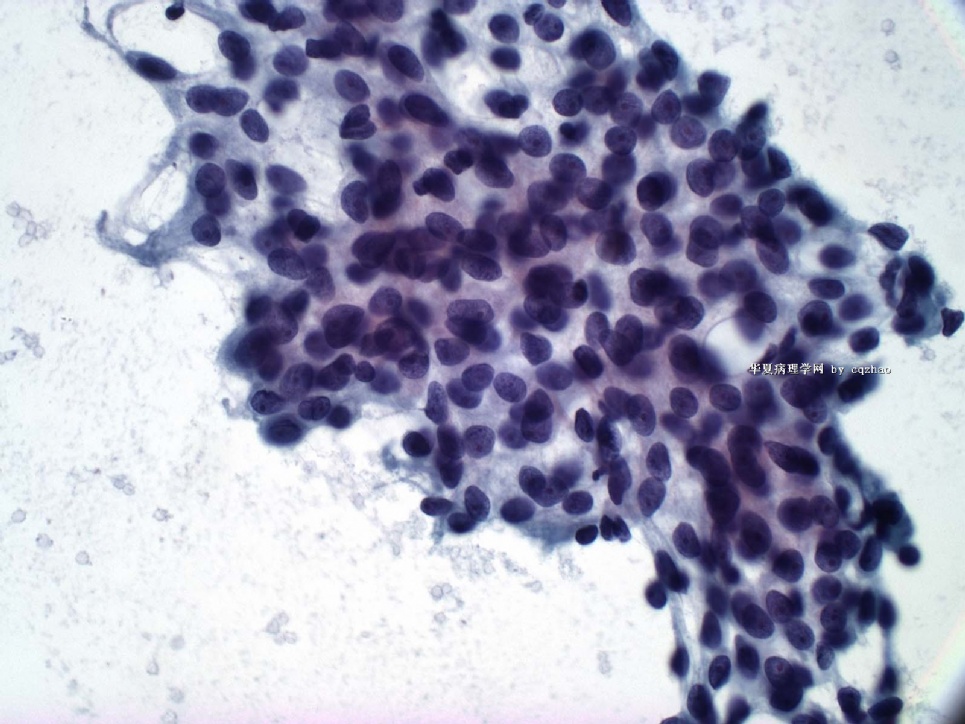
名称:图1
描述:图1
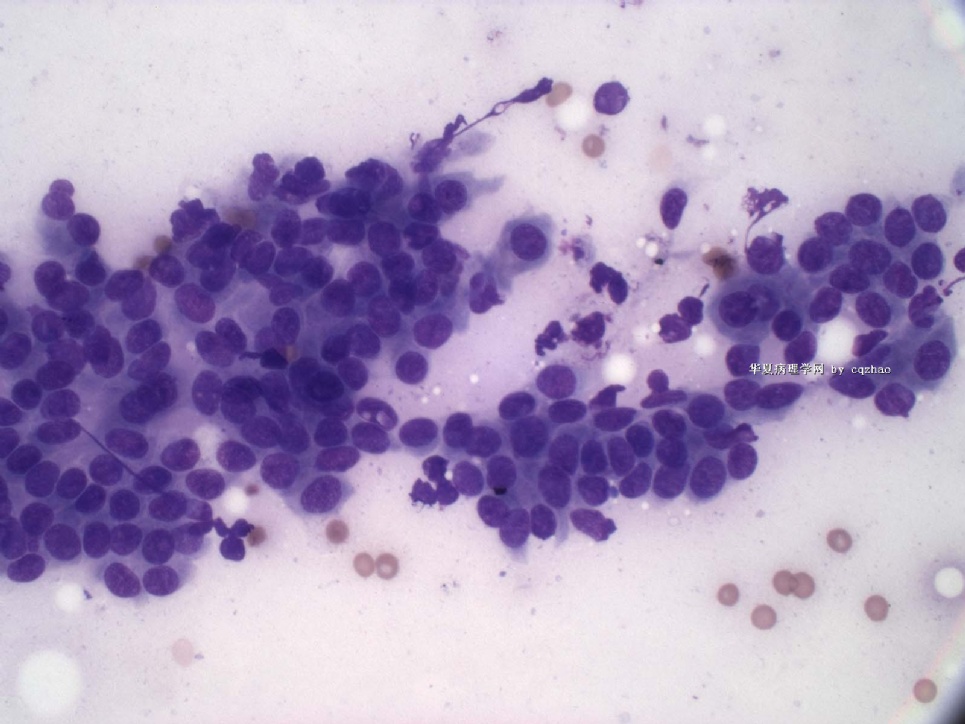
名称:图2
描述:图2
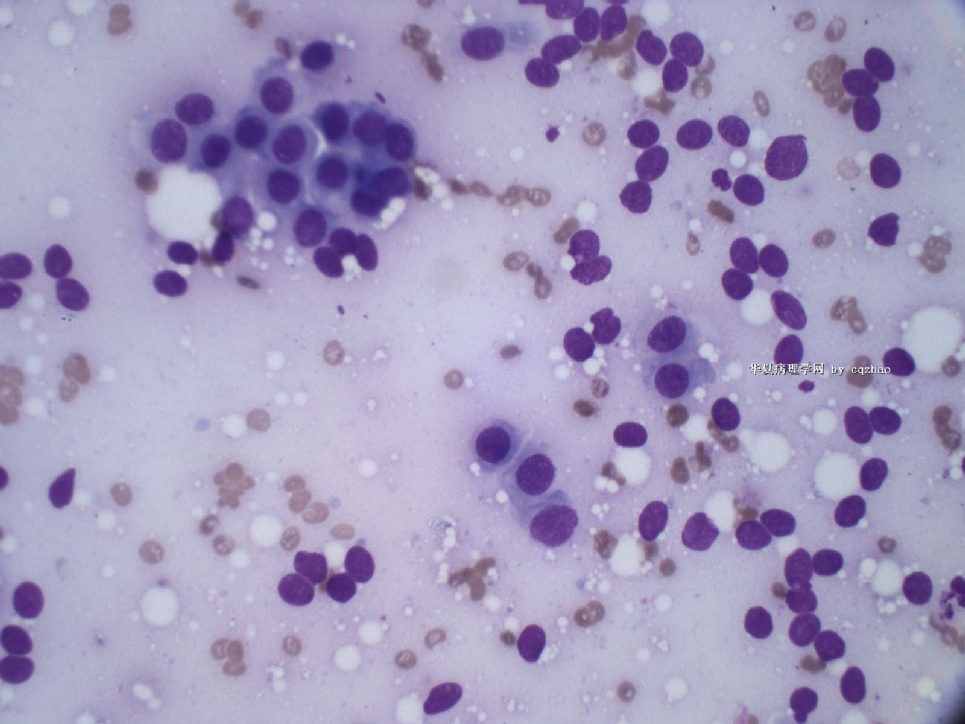
名称:图3
描述:图3
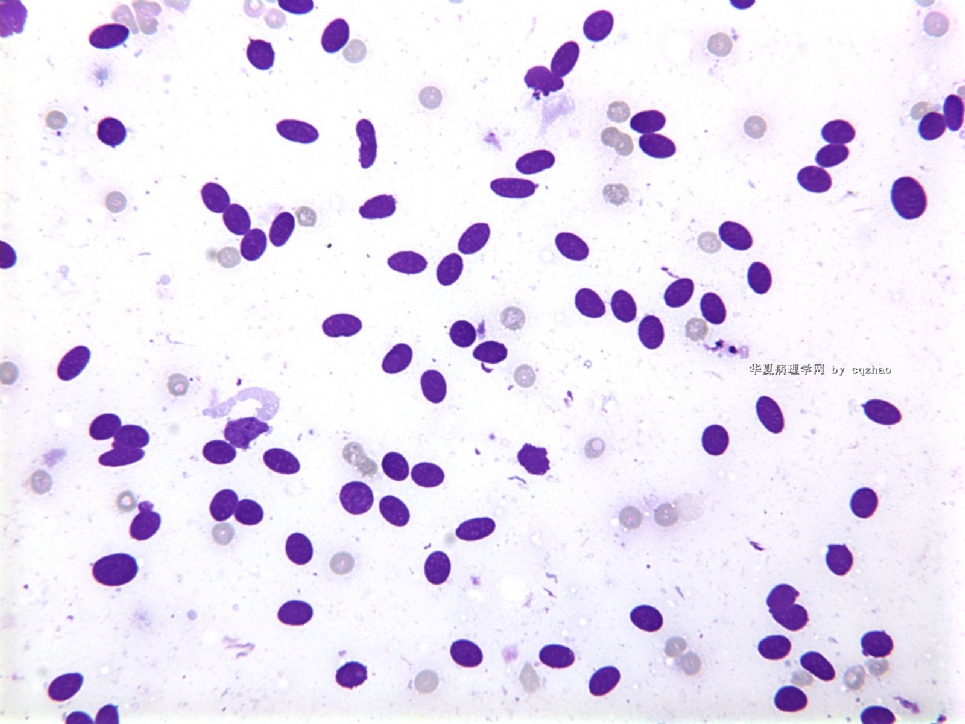
名称:图4
描述:图4
-
本帖最后由 于 2009-04-14 06:20:00 编辑
Figure 1. Four cases of atypical proliferative breast lesions on FNA cytology and diagnosed as invasive carcinoma on histology specimens. (A) Small clusters of cells with small, round, and uniform nuclei in a tubular carcinoma case; (B) hypocellular specimen with few clusters of ductal epithelial cells with cytologic atypia in an invasive ductal carcinoma case; (C) one cluster of cells with small, round, and uniform nuclei in an invasive lobular carcinoma case; (D) one very cohesive cluster of ductal epithelial cells with mild cytologic atypia in an invasive ductal carcinoma case (A-D: Papanicolaou stain, original magnification ×400).
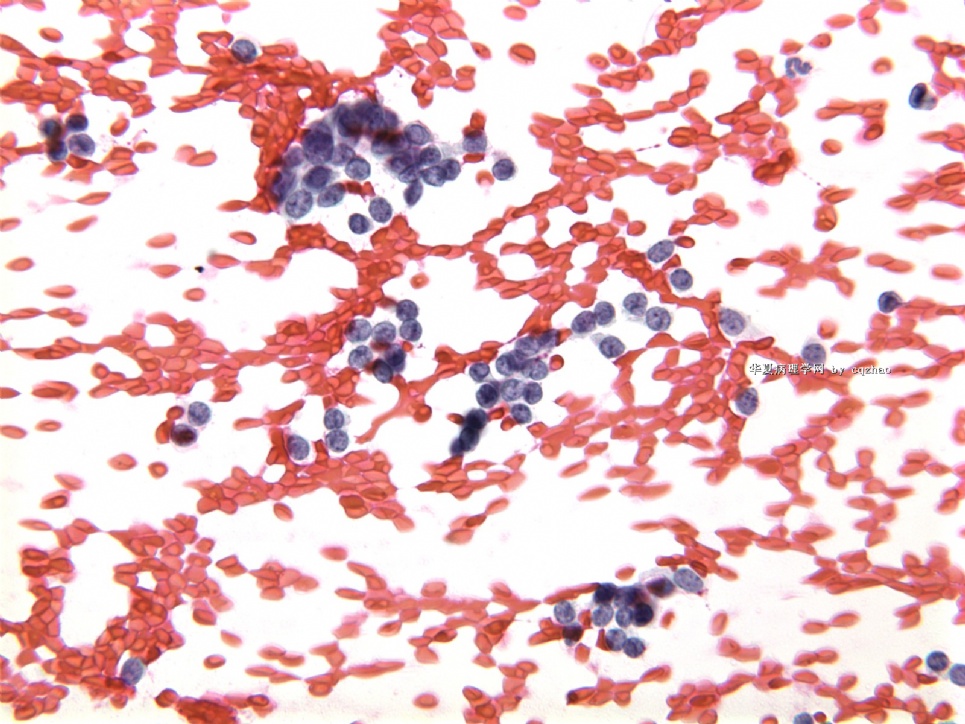
名称:图1
描述:图1

名称:图2
描述:图2

名称:图3
描述:图3
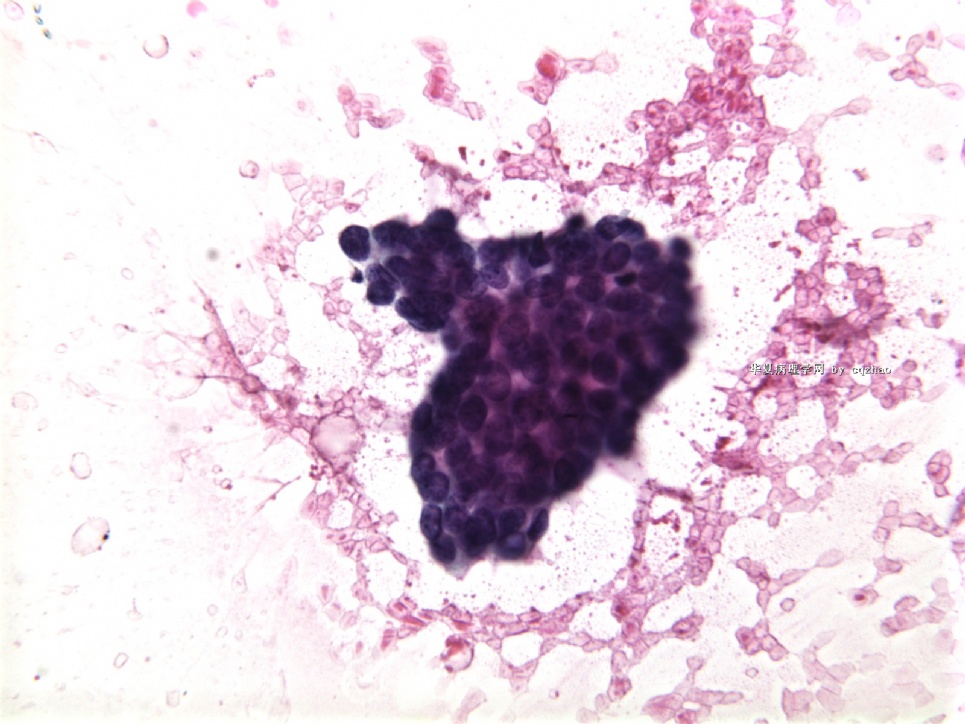
名称:图4
描述:图4
| Table 5. Cytologic Features of 99 Fibroadenoma Diagnosed as Proliferative Breast Lesions in Fine-Needle Aspiration | ||||||||||||||||||||||||||||||||||||||||||||||||||||||||||||||||
|
| ||||||||||||||||||||||||||||||||||||||||||||||||||||||||||||||||
| ||||||||||||||||||||||||||||||||||||||||||||||||||||||||||||||||
|
| ||||||||||||||||||||||||||||||||||||||||||||||||||||||||||||||||
| Table 3. Cytologic Features of 15 Invasive Breast Carcinomas | ||||||||||||||||||||||||||||||||||||||||||||||||||||||||||
|
| ||||||||||||||||||||||||||||||||||||||||||||||||||||||||||
| ||||||||||||||||||||||||||||||||||||||||||||||||||||||||||
|
| ||||||||||||||||||||||||||||||||||||||||||||||||||||||||||
| Table 4. Surgical Features of 15 Invasive Carcinomas | ||||||||||||||||||||||||||||||
|
| ||||||||||||||||||||||||||||||
| ||||||||||||||||||||||||||||||
|
| ||||||||||||||||||||||||||||||
| Table 1. Patients' Ages and Tumor Sizes | |||||||||||||||||||||||||||||||||||||||||||||
|
| |||||||||||||||||||||||||||||||||||||||||||||
| |||||||||||||||||||||||||||||||||||||||||||||
|
| |||||||||||||||||||||||||||||||||||||||||||||
| FA indicates fibroadenoma. * The P value was derived from the Student t Test. |
| Table 2. Correlation of Cytologic and Histologic Diagnosis in 172 Patients With Proliferative Breast Lesions | ||||||||||||||||||||||||||||||||||||||||||||||||||||||||||||||||||||||||||||||||||||||||||||||||
|
| ||||||||||||||||||||||||||||||||||||||||||||||||||||||||||||||||||||||||||||||||||||||||||||||||
| ||||||||||||||||||||||||||||||||||||||||||||||||||||||||||||||||||||||||||||||||||||||||||||||||
|
| ||||||||||||||||||||||||||||||||||||||||||||||||||||||||||||||||||||||||||||||||||||||||||||||||
| * Including a few cases of atypical ductal hyperplasia and atypical lobular hyperplasia. |
















